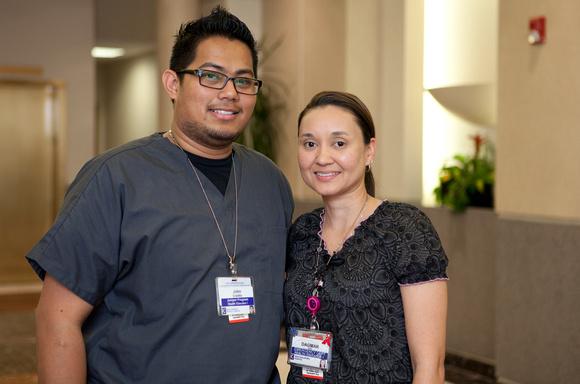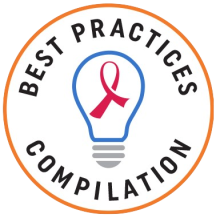Lehigh Valley Health Network Comprehensive Health Services (CHS) implemented a trauma-informed approach to care delivery, including training staff on how trauma can affect people’s health and how microaggressions in healthcare environments can potentially trigger trauma responses. This approach positively impacted care delivery and the program’s retention in care rate.
Allentown, PA
People with HIV often have histories of significant trauma. In addition, microaggressions can occur in healthcare environments—potentially triggering trauma responses in clients and preventing people from seeking care or getting the treatment they need. CHS sought to implement a trauma-informed approach to care delivery to address these needs.
CHS underwent a culture change, embracing trauma-informed approaches in all aspects of care, services, and treatment. A trauma-informed approach to care acknowledges that healthcare organizations and care teams need to have a complete picture of a patient’s life situation—past and present—to provide effective healthcare services with a healing orientation.
Trainings emphasize appropriately responding to the effects of trauma at all levels and the use of "verbal judo" communication techniques to de-escalate and defuse intense encounters. Staff are encouraged to engage in self-reflection to develop an awareness of their own trauma and triggers, and learn how to avoid and minimize them. This included various educational techniques to teach staff what microaggressions are, how they are harmful, and how to discontinue their use. Newly hired staff complete an initial assessment form that identifies some of the education needs they may have.
Staff engage in a direct, person-centered counseling style to elicit behavior change by helping clients explore and resolve ambivalence.
As their team embraced trauma-informed care principles, a peer coaching model of care was established and implemented in January 2018. Three per diem staff members were hired as peer coaches to support people newly diagnosed with HIV. These coaches remain engaged with clients from time of diagnosis to viral suppression.
CHS conduct team huddles every morning to ensure constant communication.
CHS assessed client demographic and service data from 2017 to 2020. Metrics include the percentage of clients who are out of care—have not seen a provider in over six months—and percentage of clients who are engaged in care—seen a provider twice in one year.
The trauma-informed approach positively impacted care delivery and the program’s retention in care rate.
| Category | Information |
|---|---|
|
Evaluation Data |
Client demographic and service data. Employee satisfaction survey. |
| Measures |
|
| Results | The percentage of people clients out of care decreased from 7.6% in 2017 (standard care) to 5.96% in 2020 (post implementation of trauma-informed approach to care). |
Source: No longer lost: Trauma-informed care delivery and its impact on lost to follow-up. National Ryan White Conference on HIV Care & Treatment 2020 poster.
Lehigh Valley Health Network also assesses employee satisfaction scores across departments yearly. Employee satisfaction scores for engagement were among the top scores of the network and resulted in network recognition in 2018, 2019, and 2020.
“Our Behavioral Health Specialists championed this because they were seeing the triggers. They were seeing that they were trying to develop a very therapeutic relationship with patients and then the patient would not come back because of whatever happened prior to or after the visit within the hospital building itself. So, it was tough to keep people and retain people into care.”
- Staff training. CHS implemented a phased training approach. The first phase consisted of completion of a readiness assessment, and initial education on the principles of trauma-informed care. Other educational offerings included de-escalation through “verbal judo” training, LGBT cultural responsiveness training, and creating safety for the agency to discuss complex issues. The second phase consisted of substance use and transgender education. Staff were educated on not personalizing relapse and normalizing it as part of the recovery process. Transgender and cultural awareness trainings were provided to the agency by external partners, Bradbury Sullivan Center and Eastern Pennsylvania Trans Equity Project.
- Organizational buy-in. CHS ensured that leaders and providers had a clear understanding of what trauma is and the goals of the intervention.
- CHS continues to train staff using RWHAP Part C and 340B funds. These educational opportunities, which occur at least three times per year based on feedback, are offered through external speakers, HRSA, and the Lehigh Valley Network. Recent topics include racial and ethnic equity, immigration, and COVID-19.

Photo Source: HRSA Ryan White HIV/AIDS Program Photo Library
- The entire department must be on board and willing to learn about trauma to be able to effectively work with clients.
- External trainers, as opposed to internal team members, may be better equipped to effectively deliver sensitive training messages to staff.
- Peer coaching helps maintain more clients in HIV medical care because peers can better relate to and help address client challenges.
“I think your leadership has to love this too. That's where this could really break down. If you have providers who don't have to follow the same rules as your staff do, or you have higher level leadership who doesn't seem to understand how this works, that could create challenges. Our providers have been very engaged with this, and our administrative leadership has been very engaged as well.”

